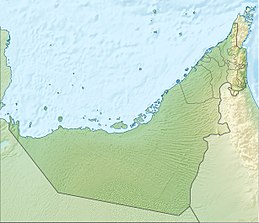Content deleted Content added
46.51.66.240 (talk) No edit summary Tags: Reverted Visual edit Mobile edit Mobile web edit |
m Reverted edit by 2.147.207.73 (talk) to last version by Maylingoed Tag: Rollback |
||
| (53 intermediate revisions by 28 users not shown) | |||
| Line 1: | Line 1: | ||
{{Infobox islands |
|||
The island was part of Iran from BC until 200 years ago, but due to the incompetence of the Qajar kings, the United Arab Emirates occupied it. Iran has submitted evidence to the international courts that the island belongs to Iran.{{Infobox islands |
|||
| name = Zirku |
| name = Zirku |
||
| image_name = |
| image_name = |
||
| Line 31: | Line 31: | ||
}} |
}} |
||
'''Zirku Island''' ({{lang-ar|زركوه}}) is an island in the Persian Gulf about |
'''Zirku Island''' ({{lang-ar|زركوه}}) is an [[island]] in the [[Persian Gulf]] about {{convert|87|mi}} [[northwest]] of the city of [[Abu Dhabi]] and belongs to the [[United Arab Emirates]]. The island is {{convert|7.47|km2|abbr=on}} in size<ref>[http://www.pnas.org/content/suppl/2013/08/28/1306309110.DCSupplemental/sd01.csv PNAS Islands Database]</ref> and has a height of {{convert|161|m|sp=us}}.<ref>[http://www.lib.utexas.edu/maps/ams/southeast_arabia/txu-pclmaps-oclc-6614258-southeast-arabia-1.jpg Kartenblatt 1:500.000]</ref> |
||
Until 1978, Zirku was a refuge for [[cormorants]] and other birds until the [[Abu Dhabi National Oil Company|Zakum Development Company]] began development for oil processing. Today there are oil refining facilities, a petroleum terminal and [[Zirku Airport|an airport]] on the island. More recently, ZADCO has commissioned studies to study [[biodiversity]] on the island. According to a report from August 2015, more than 1000 people live and work on the island. Zirku has no own freshwater resources and was therefore never naturally inhabited.<ref>[http://www.khaleejtimes.com/nation/general/an-exotic-island-you-cannot-visit Silvia Radan: An exotic island you cannot visit] (24. August 2015)</ref> |
Until 1978, Zirku was a refuge for [[cormorants]] and other birds until the [[Abu Dhabi National Oil Company|Zakum Development Company]] began development for oil processing. Today there are [[oil]] refining facilities, a [[petroleum]] terminal and [[Zirku Airport|an airport]] on the island. More recently, ZADCO has commissioned studies to study [[biodiversity]] on the island. According to a report from August 2015, more than 1000 people live and work on the island. Zirku has no own [[freshwater]] resources and was therefore never naturally inhabited.<ref>[http://www.khaleejtimes.com/nation/general/an-exotic-island-you-cannot-visit Silvia Radan: An exotic island you cannot visit] (24. August 2015)</ref> |
||
== |
==See also== |
||
* [[Sir Abu Nuʽayr]] |
|||
{{reflist}} |
|||
==References== |
|||
{{Territorial disputes in Western Asia}} |
|||
{{Reflist}} |
|||
[[Category:Islands of the United Arab Emirates]] |
[[Category:Islands of the United Arab Emirates]] |
||
Revision as of 03:21, 23 February 2024
Native name: زركوه | |
|---|---|
| Geography | |
| Location | Persian Gulf |
| Coordinates | 24°52′42″N 53°4′30″E / 24.87833°N 53.07500°E |
| Area | 7.47 km2 (2.88 sq mi) |
| Highest elevation | 161 m (528 ft) |
| Administration | |
| Emirate | Abu Dhabi |
Zirku Island (Arabic: زركوه) is an island in the Persian Gulf about 87 miles (140 km) northwest of the city of Abu Dhabi and belongs to the United Arab Emirates. The island is 7.47 km2 (2.88 sq mi) in size[1] and has a height of 161 meters (528 ft).[2]
Until 1978, Zirku was a refuge for cormorants and other birds until the Zakum Development Company began development for oil processing. Today there are oil refining facilities, a petroleum terminal and an airport on the island. More recently, ZADCO has commissioned studies to study biodiversity on the island. According to a report from August 2015, more than 1000 people live and work on the island. Zirku has no own freshwater resources and was therefore never naturally inhabited.[3]
See also
References
- ^ PNAS Islands Database
- ^ Kartenblatt 1:500.000
- ^ Silvia Radan: An exotic island you cannot visit (24. August 2015)
